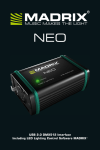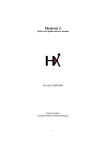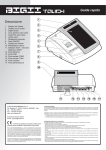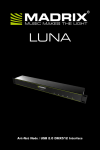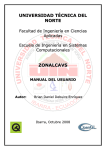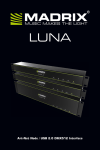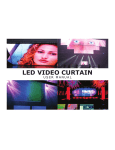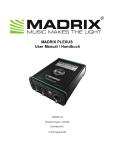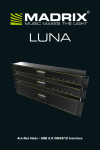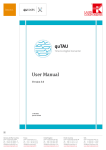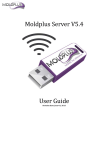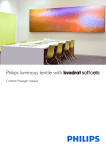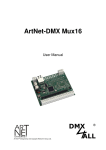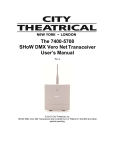Download MADRIX 3 Fixture Editor Help And Manual
Transcript
MADRIX 3 Fixture Editor Help And Manual [Software User Guide] MADRIX Version: 3.2. Date: March 2014 © 2014 inoage GmbH Table Of Contents Table Of Contents Part A MA D RIX 3 Fixture Editor 4 1 Important Notes . . . . . . . . . . . . . . . . . . . . . . . . . . . . . . . . . . . . . . . . . . . . . . . . . . . . . . . 5 2 Getting Started . . . . . . . . . . . . . . . . . . . . . . . . . . . . . . . . . . . . . . . . . . . . . . . . . . . . . . . 6 3 Managing Fixture . .Libraries . . . . . . . . . . . . . . . . . . . . . . . . . . . . . . . . . . . . . . . . . . . . . . . . . . . . . 10 4 Managing Fixtures . . . . . . . . . . . . . . . . . . . . . . . . . . . . . . . . . . . . . . . . . . . . . . . . . . . . . . . 13 5 Configuration of. Fixture . . . . . . Profiles . . . . . . . . . . . . . . . . . . . . . . . . . . . . . . . . . . . . . . . . . . . . . . . . 15 Part B Im print & C opyright Index www.madrix.com 22 0 //2 //PART A MADRIX 3 Fixture Editor MADRIX Fixture Editor 3.2. 1 [Part A] MADRIX 3 Fixture Editor MADRIX 3 Fixture Editor This topic includes: Introduction Usage Where To Find The MADRIX Fixture Editor Introduction The MADRIX 3 Fixture Editor is a separate application and useful tool to create and configure lighting fixtures for MADRIX. LED fixtures are implemented into MADRIX using the MADRIX Fixture Editor. All the fixtures, their profiles and configurations are stored in the MADRIX Fixture Library (madrix.mflx). This is a separate file. MADRIX will access this file to load all available fixture configurations. Usage With the help of the MADRIX Fixture Editor, you can: see how fixtures are implemented in MADRIX. see how many and which fixtures are already included. adjust settings and profiles to your requirements. implement and add new fixture configurations to the library yourself. Where To Find The MADRIX Fixture Editor The Fixture Editor is automatically installed together with MADRIX. You can access the tool or its documentation by calling up the shortcut in the Windows Start Menu or in the MADRIX installation directory. In Windows, go to Start > All Programs > MADRIX 3 > Fixture Editor www.madrix.com //4 MADRIX Fixture Editor 3.2. [Part A] MADRIX 3 Fixture Editor The original, executable program can be found in the MADRIX installation directory: C:\Program Files (x86)\MADRIX3 1.1 Important Notes The MADRIX Fixture Library is loaded into MADRIX, when the MADRIX software is launched. In this way, MADRIX will load the new settings and profiles during start-up. MADRIX needs to be restarted when changes have been made to the fixture library. MADRIX can only access 1 MADRIX Fixture Library during run-time. All fixture profiles that are required need to be in 1 library file. By default, MADRIX loads the madrix.mflx, which is the original MADRIX Fixture Library. MADRIX allows you to load a fixture library that is not the default MADRIX Fixture Library [In MADRIX, go to Preferences > Options... > Start Options > Load A Special Fixture Library]. MADRIX 3 Fixture Editor can load MADRIX 2.X Fixture Libraries [*.mfl] as well as MADRIX 3.X Fixture Libraries [*.mflx]. MADRIX 3 Fixture Editor can save only MADRIX 3.X Fixture Libraries [*.mflx]. MADRIX 3 Fixture Editor can load MADRIX 2.X Fixtures [*.mfx] as well as MADRIX 3.X Fixtures [*. mfxx]. MADRIX 3 Fixture Editor can save only MADRIX 3.X Fixtures [*.mfxx]. Always make a backup of the madrix.mflx before and after applying any changes! When updating your MADRIX software, the Setup (Auto Installer) will completely overwrite the current madrix.mflx in order to update the library. When updating your MADRIX software, the Setup (Auto Installer) will automatically create a "madrix.mflx.bak". This file is a backup of your previous MADRIX Fixture Library. www.madrix.com //5 MADRIX Fixture Editor 3.2. 1.2 [Part A] MADRIX 3 Fixture Editor Getting Started This topic includes: Getting Started Choosing The Language Overview Fixture Library Fixture And Channel Fixture Preview Getting Started If you open the MADRIX 3 Fixture Editor, you will see that no fixture library is loaded. At first, the tool is empty. To load the original MADRIX Fixture Library file: 1] Select File > Open Library... [Keyboard shortcut: Ctrl+O] 2] A new window will open. 3] Navigate to the installation directory of MADRIX: - C:\Program Files (x86)\MADRIX3 4] Choose madrix.mflx and press Open Choosing The Language Before starting work with the MADRIX Fixture Editor, you can choose the language of the user interface. In the menu Language, choose from: - English [Keyboard shortcut: Ctrl+Shift+Alt+E] - Deutsch [German] [Keyboard shortcut: Ctrl+Shift+Alt+D] [This user manual only includes English.] www.madrix.com //6 MADRIX Fixture Editor 3.2. [Part A] MADRIX 3 Fixture Editor Overview The MADRIX 3 Fixture Editor window is divided into 3 parts [from left to right]: A Fixture Library list Fixture and Channel overviews A Fixture preview www.madrix.com //7 MADRIX Fixture Editor 3.2. [Part A] MADRIX 3 Fixture Editor Fixture Library On the left-hand side, a tree structure represents the content of the currently loaded fixture library. The items are arranged in alphabetical order. Each top branch of the structure names a lighting fixtures manufacturer. Every item has one or more sub-items representing the fixture profile or a variation of the fixture profile for different modes. Expands the complete list of fixtures with all of its entries. Collapses all entries of the list. Allows you to edit the selected fixture profile. First, select one fixture profile from the list. Fixture And Channels In the center of the Fixture Editor window, the configuration for the currently selected fixture and channels is displayed and can be changed. Learn more »Configuration Of Fixture Profiles Fixture Preview The area on the right-hand side of the Fixture Editor serves as a preview while editing. The upper part shows a graphical model of the fixture. The pixel or voxel belonging to the currently selected channel is highlighted with the specified color. Additionally, the lower part summarizes all information [channels, colors, positions, values, types, and names] of this pixel/voxel. The preview is updated every time you edit the fixture profile. www.madrix.com //8 MADRIX Fixture Editor 3.2. www.madrix.com [Part A] MADRIX 3 Fixture Editor //9 MADRIX Fixture Editor 3.2. 1.3 [Part A] MADRIX 3 Fixture Editor Managing Fixture Libraries This topic includes: Overview Creating A New Library Loading A Library Adding A Library Saving A Library Checking A Library For Errors Overview File - Use this menu to manage your original MADRIX Fixture Library [and additional libraries]. File > Recent Files - Displays libraries that were previously loaded. File > Exit - Closes the Fixture Editor. Creating A New Library File > New Library - Creates a new library. This library will not include any fixture profiles yet. Loading A Library www.madrix.com //10 MADRIX Fixture Editor 3.2. [Part A] MADRIX 3 Fixture Editor File > Open Library... - Loads a fixture library into the MADRIX Fixture Editor. This will open a new window for yout to choose the fixture library. [A fixture library file has the extension *.mflx.] If you open the MADRIX 3 Fixture Editor, you will see that no fixture library is loaded. At first, the fixture library is empty. To open the original MADRIX Fixture Library file: 1] Select File > Open Library... [Keyboard shortcut: Ctrl+O] 2] Navigate to the installation directory of MADRX: - C:\Program Files (x86)\MADRIX3 3] Choose madrix.mflx and press Open Adding A Library File > Add Library... - Allows you to add other libraries to the currently loaded library in order to merge several library files, for example [add and append]. Saving A Library File > Save Library - Saves a library file including all the changes you have made. This will change your currently loaded fixture library. File > Save Library As... - Saves a library file including all the changes you have made into a new file. This will open a new window. Choose the location, enter a name for the new file, and press Save Modifications to your library cannot simply get lost. You will have to confirm it if you want to quit the MADRIX 3 Fixture Editor without having saved. If the library was modified, the title bar shows an asterisk, too. www.madrix.com //11 MADRIX Fixture Editor 3.2. [Part A] MADRIX 3 Fixture Editor Checking A Library For Errors File > Check Library... - Checks the fixture library for logical errors. The Fixture Editor will look for logical errors, such as having a defined a Color Depth of 4, but only including 3 channels for the fixture. This option is useful if you want to have an automatic check up after having implemented new fixtures. But the option should not replace checking the fixture profile for errors yourself. www.madrix.com //12 MADRIX Fixture Editor 3.2. 1.4 [Part A] MADRIX 3 Fixture Editor Managing Fixtures This topic includes: Overview Creating A New Fixture Copying A Fixture Editing A Fixture Deleting A Fixture Loading And Saving A Fixture Overview Fixtures - Use this menu to manage your fixture profiles. Creating A New Fixture Fixtures > Add New Fixture - Allows you to create a new fixture profile. Make sure to edit all Fixture and Channel settings afterwards. Learn more »Configuration Of Fixture Profiles Copying A Fixture www.madrix.com //13 MADRIX Fixture Editor 3.2. [Part A] MADRIX 3 Fixture Editor Fixtures > Copy Fixture - Allows you to copy a current fixture profile and edit the settings in order to create a new fixture profile based on another profile. Make sure to edit all Fixture and Channel settings afterwards. Learn more »Configuration Of Fixture Profiles Editing A Fixture Fixtures > Edit Fixture - Allows you to edit all settings of a fixture profile. Learn more »Configuration Of Fixture Profiles Deleting A Fixture Fixtures > Delete Fixture - Instantly removes the currently selected fixture profile from the library. Loading And Saving A Fixture Fixtures > Open Fixture... - Allows you to load a fixture from an external file [MADRIX Fixture of the file type *. mfxx]. The fixture profile will be added to the fixture library. Fixtures > Save Fixture... - Allows you to save a fixture to an external file [MADRIX Fixture of the file type *. mfxx]. First, select a fixture. Second, go to Fixtures > Save Fixture.... Third, a new window opens. Fourth, enter a file name, open the correct location to save the file, and press Save. www.madrix.com //14 MADRIX Fixture Editor 3.2. 1.5 [Part A] MADRIX 3 Fixture Editor Configuration of Fixture Profiles This topic includes: Introduction Step-By-Step Configuration Settings Introduction This topic describes how to create and how to set up a new fixture. This is the most important part when creating a new fixture profile. Step-By-Step Configuration 1] Load a MADRIX Fixture Library. 2] Create a new fixture or copy an existing profile. 3] Configure all fixture settings. 4] Save the fixture library. 1] Loading A Library First, make sure to load an existing MADRIX Fixture Library or create a new library. Learn more »Managing Fixture Libraries 2] Creating Or Copying A Fixture Create a completely new fixture profile or copy a profile to edit its available settings. Learn more »Managing Fixtures www.madrix.com //15 MADRIX Fixture Editor 3.2. [Part A] MADRIX 3 Fixture Editor 3] Setting Up A Profile Make sure to set up all settings, including Fixture Settings as well as Channel Settings. Press Apply and OK to confirm your changes! Learn more below 4] Saving The Library Make sure to save your library after making any chances. Learn more »Managing Fixture Libraries Settings Overview Each fixture profile includes two types of settings: Fixture Settings [Includes data about the fixture in general] Channel Settings [Includes detailed data about each DMX channel/color channel] Edit Fixture Go to Fixtures > Edit Fixture in order to be able to edit all settings as described below [Edit mode]. Or Double-click on a fixture in the Fixture Library list. Fixture Settings www.madrix.com //16 MADRIX Fixture Editor 3.2. [Part A] MADRIX 3 Fixture Editor Set up the following settings: Manufacturer - Enter the name of the manufacturer. Homepage - Enter the website of the manufacturer. Press Call to let Windows automatically open your default web browser and launch the website. Fixture Name - Enter the complete name of the fixture. Short Name - Enter a short label for the fixture. Protocol Name - Fixtures might have several modes or come in different types. Specify the type or mode here [e.g., 54ch - 54 DMX channel mode]. Type - Specify if the fixture is controlled via DMX512 [or DMX-based in general] or via DVI [or DVI-based in general]. DMX-based types include protocols that are based on DMX512 or function similar [e.g., KiNet or ArtNet]. Voxel Amount X / Y / Z - Specify how many pixels/voxels the fixture has in X [horizontal], Y [vertical], and Z [depth]. Color Depth - Specify the color mixing mode of your fixture or in other words how many channels one voxel/ pixel of your fixture requires [e.g., RGB fixtures use 3 channels per voxel/pixel, while RGBW fixtures require a color depth of 4.] You can enter the values directly, or you can use the drop-down list to define the color mode: W hite, RG, RGB, or RGBW DMX Channel Amount - Is only available for DMX-based fixtures. Enter the total number of DMX channels which the fixture requires [e.g., a 16-pixel RGB fixture usually requires 48 DMX channels per fixture]. www.madrix.com //17 MADRIX Fixture Editor 3.2. [Part A] MADRIX 3 Fixture Editor DMX Address Min / Max - Is only available for DMX-based fixtures. Enter the lowest DMX channel address possible for this fixture and power supply/controller [usually 1]. Enter the highest DMX channel address possible for this fixture and power supply/controller [usually 512; but if you have a 150-channels fixture and you can only address one fixture per controller for example, then DMX Address Max should be 150. In this way, you can only add one fixture per controller and DMX universe]. Channel Settings + - Creates a new channel and adds it to the fixture profile. Make sure to correctly set up all settings for this channel as explained below. - Deletes a channel from the list of channels. Up - Moves an entry one place up in the list of channels. Select the particular channel first. Down- Moves an entry one place down in the list of channels. Select the particular channel first. OK - Confirms your settings for the fixture profile and leaves Edit mode. Apply - Confirms your settings, but you will stay in Edit mode and you can change further settings. www.madrix.com //18 MADRIX Fixture Editor 3.2. [Part A] MADRIX 3 Fixture Editor Cancel - Aborts the process and does not confirm any changes. All changes will be discarded. You will leave Edit mode. Set up the following settings: Channel # - Specifies the channel number. Especially, when using DMX-based fixtures, every channel has a specific function. Make sure to set up the channels correctly. Absolute - Sets the channel as a global identifier. This is optional. There are manufacturers that allow several fixtures to use one master channel, for example. Name - Allows you to change the name of the channel. This name will be displayed in the list of channels to the left and in the preview to the right. Type - Specifies if the channel is of a certain type. HTP - Activates Highest Takes Precedence for this channel. [Is a feature only used in special cases. For example, you have 2 fixtures with the same DMX address. But due to their different locations in the MADRIX Patch, they receive different color values. If HTP is activated for these fixtures, the highest color value will be put out onto the LEDs. Otherwise, the position in the patch decides which color value is send out. The latter position wins.] Default Value - Specifies the default value for this channel [initial value]. Fixed - Sets the channel always to the Default Value and does not allow any changes to the values, when working with the fixture in MADRIX. [E.g, a fixture might require the master channel to always be 255 in order to work correctly]. Value Min / Max - Limits the value range with an lower and upper limit. By default, the values of a DMX channel range from 0 to 255. 0 represents Off, while 255 represents Full On. Some fixtures might work with a different range of values or require a certain minimal value to avoid flickering. Invert - Some fixture might work the other way around [0 = On and 255 = Off]. Activate Invert in this case. Color # - Defines which color the channel controls. Choose from Red, Green, Blue, or W hite [according to the Color Depth]. Voxel Pos X - Defines the horizontal position of the channel on the fixture. [Fixtures of MADRIX work on a voxel/ pixel basis. For example, 1/1/1 for example represents the upper left voxel/pixel.] Voxel Pos Y - Defines the vertical position of the channel on the fixture. [Fixtures of MADRIX work on a voxel/ pixel basis. For example, 1/1/1 for example represents the upper left voxel/pixel.] Voxel Pos Z - Defines the depth position of the channel on the fixture. [Fixtures of MADRIX work on a voxel/pixel basis. For example, 1/1/1 for example represents the upper left voxel/pixel.] www.madrix.com //19 MADRIX Fixture Editor 3.2. [Part A] MADRIX 3 Fixture Editor Confirm Settings Press Apply and OK to confirm any changes. www.madrix.com //20 //PART B Imprint & Copyright MADRIX Fixture Editor 3.2. 2 [Part B] Imprint & Copyright Imprint & Copyright This topic includes: Company And Address Copyright Third Parties Company And Address inoage GmbH Wiener Straße 56 D-01219 Dresden Germany Managing Directors: Christian Hertel, Sebastian Pinzer, Sebastian Wissmann Phone: +49 351 482 056 30 Fax: +49 351 482 056 31 WWW: http://www.madrix.com E-mail: [email protected] Copyright MADRIX is a registered trademark of inoage GmbH. All other company names and/or product names are trademarks and/or entered trademarks of their respective holders. The product might not always be conforming to the presentation, features, and performances. Technical data can differ slightly, depending on the operating system and the chosen hardware. www.madrix.com //22 MADRIX Fixture Editor 3.2. [Part B] Imprint & Copyright We withhold the option of changes without notification. inoage GmbH does not give any guaranty for function capability for a certain purpose, the marked ability or other features of the product. No other guaranty claims, on legal or other terms, can be enforced. Under no circumstances does inoage GmbH take on the responsibility for liabilities for faults for loses in sales volume or profits, that occur through the usage of the product, through the serviceability, through abuse, happenings, circumstances or actions, that we have no influence on. No matter if the damages were caused by the holder of the product or a third person. Copyright (c) 2001 - 2014 inoage GmbH. All rights reserved. Third Parties Qt Included Libraries MADRIX [in this case the MADRIX Fixture Editor] uses the following libraries of the Qt development framework. The libraries and their use are covered by GNU LGPL v.2.1. QtCore4.dll QtGui4.dll QtOpenGL4.dll QtXml4.dll QtSvg4.dll qgif4.dll (Qt Plugin DLL) qico4.dll (Qt Plugin DLL) qjpeg4.dll (Qt Plugin DLL) qmng4.dll (Qt Plugin DLL) qsvg4.dll (Qt Plugin DLL) qtiff4.dll (Qt Plugin DLL) www.madrix.com //23 MADRIX Fixture Editor 3.2. [Part B] Imprint & Copyright The complete, corresponding, and machine-readable source code of these files, incl. the license text, is available: On the MADRIX product CD, in the subfolder ThirdParty. For example, D:\MADRIX3\ThirdParty Online at http://www.madrix.com/en/home/download/madrix-software.html Copy of License GNU LESSER GENERAL PUBLIC LICENSE Version 2.1, February 1999 Copyright (C) 1991, 1999 Free Software Foundation, Inc. 51 Franklin Street, Fifth Floor, Boston, MA 02110-1301 USA Everyone is permitted to copy and distribute verbatim copies of this license document, but changing it is not allowed. [This is the first released version of the Lesser GPL. It also counts as the successor of the GNU Library Public License, version 2, hence the version number 2.1.] Preamble The licenses for most software are designed to take away your freedom to share and change it. By contrast, the GNU General Public Licenses are intended to guarantee your freedom to share and change free software--to make sure the software is free for all its users. This license, the Lesser General Public License, applies to some specially designated software packages--typically libraries--of the Free Software Foundation and other authors who decide to use it. You can use it too, but we suggest you first think carefully about whether this license or the ordinary General Public License is the better strategy to use in any particular case, based on the explanations below. When we speak of free software, we are referring to freedom of use, not price. Our General Public Licenses are designed to make sure that you have the freedom to distribute copies of free software (and charge for this service if you wish); that you receive source code or can get it if you want it; that you can change the software and use pieces of it in new free programs; and that you are informed that you can do these things. To protect your rights, we need to make restrictions that forbid distributors to deny you these rights or to ask you to surrender these rights. These restrictions translate to certain responsibilities for you if you distribute copies of the library or if you modify it. www.madrix.com //24 MADRIX Fixture Editor 3.2. [Part B] Imprint & Copyright For example, if you distribute copies of the library, whether gratis or for a fee, you must give the recipients all the rights that we gave you. You must make sure that they, too, receive or can get the source code. If you link other code with the library, you must provide complete object files to the recipients, so that they can relink them with the library after making changes to the library and recompiling it. And you must show them these terms so they know their rights. We protect your rights with a two-step method: (1) we copyright the library, and (2) we offer you this license, which gives you legal permission to copy, distribute and/or modify the library. To protect each distributor, we want to make it very clear that there is no warranty for the free library. Also, if the library is modified by someone else and passed on, the recipients should know that what they have is not the original version, so that the original author's reputation will not be affected by problems that might be introduced by others. Finally, software patents pose a constant threat to the existence of any free program. We wish to make sure that a company cannot effectively restrict the users of a free program by obtaining a restrictive license from a patent holder. Therefore, we insist that any patent license obtained for a version of the library must be consistent with the full freedom of use specified in this license. Most GNU software, including some libraries, is covered License. This license, the GNU Lesser General Public by the License, ordinary applies GNU to General certain Public designated libraries, and is quite different from the ordinary General Public License. We use this license for certain libraries in order to permit linking those libraries into non-free programs. When a program is linked with a library, whether statically or using a combination of the two is legally speaking a combined work, a shared derivative of library, the the original library. The ordinary General Public License therefore permits such linking only if the entire combination fits its criteria of freedom. The Lesser General Public License permits more lax criteria for linking other code with the library. We call this license the "Lesser" General Public License because it does Less to protect the user's freedom than the ordinary General Public License. It also provides other free software developers Less of an advantage over competing non-free programs. These disadvantages are the reason we use the ordinary General Public License for many libraries. However, the Lesser license provides advantages in certain special circumstances. www.madrix.com //25 MADRIX Fixture Editor 3.2. [Part B] Imprint & Copyright For example, on rare occasions, there may be a special need to encourage the widest possible use of a certain library, so that it becomes a de-facto standard. To achieve this, non-free programs must be allowed to use the library. A more frequent case is that a free library does the same job as widely used non-free libraries. In this case, there is little to gain by limiting the free library to free software only, so we use the Lesser General Public License. In other cases, permission to use a particular library in non-free programs enables a greater number of people to use a large body of free software. For example, permission to use the GNU C Library in non-free programs enables many more people to use the whole GNU operating system, as well as its variant, the GNU/Linux operating system. Although the Lesser General Public License is Less protective of the users' freedom, it does ensure that the user of a program that is linked with the Library has the freedom and the wherewithal to run that program using a modified version of the Library. The precise terms and conditions for copying, distribution and modification follow. Pay close attention to the difference between a "work based on the library" and a "work that uses the library". The former contains code derived from the library, whereas the latter must be combined with the library in order to run. TERMS AND CONDITIONS FOR COPYING, DISTRIBUTION AND MODIFICATION 0. This License Agreement applies to any software library or other program which contains a notice placed by the copyright holder or other authorized party saying it may be distributed under the terms of this Lesser General Public License (also called and/or data "this License"). Each licensee is addressed as "you". A "library" means a collection of software functions prepared so as to be conveniently linked with application programs (which use some of those functions and data) to form executables. The "Library", below, refers to any such software library or work which has been distributed under these terms. A "work based on the Library" means either the Library or any derivative work under copyright law: that is to say, a work containing the Library or a portion of it, either verbatim or with modifications and/or translated straightforwardly into another language. (Hereinafter, translation is included without limitation in the term "modification".) "Source code" for a work means the preferred form of the work for making modifications to it. For a library, complete source code means all the source code for all modules it contains, plus any associated interface definition files, plus the scripts used to control compilation and installation of the library. www.madrix.com //26 MADRIX Fixture Editor 3.2. [Part B] Imprint & Copyright Activities other than copying, distribution and modification are not covered by this License; they are outside its scope. The act of running a program using the Library is not restricted, and output from such a program is covered only if its contents constitute a work based on the Library (independent of the use of the Library in a tool for writing it). Whether that is true depends on what the Library does and what the program that uses the Library does. 1. You may copy and distribute verbatim copies of the Library's complete source code as you receive it, in any medium, provided that you conspicuously and appropriately publish on each copy an appropriate copyright notice and disclaimer of warranty; keep intact all the notices that refer to this License and to the absence of any warranty; and distribute a copy of this License along with the Library. You may charge a fee for the physical act of transferring a copy, and you may at your option offer warranty protection in exchange for a fee. 2. You may modify your copy or copies of the Library or any portion of it, thus forming a work based on the Library, and copy and distribute such modifications or work under the terms of Section 1 above, provided that you also meet all of these conditions: a) The modified work must itself be a software library. b) You must cause the files modified to carry prominent notices stating that you changed the files and the date of any change. c) You must cause the whole of the work to be licensed at no charge to all third parties under the terms of this License. d) If a facility in the modified Library refers to a function or a table of data to be supplied by an application program that uses the facility, other than as an argument passed when the facility is invoked, then you must make a good faith effort to ensure that, in the event an application does not supply such function or table, the facility still operates, and performs whatever part of its purpose remains meaningful. (For example, a function in a library to compute square roots has a purpose that is entirely well-defined independent application-supplied of function the or application. table used Therefore, by this Subsection function must 2d be requires optional: that any if the application does not supply it, the square root function must still compute square roots.) These requirements apply to the modified work as a whole. If identifiable sections of that work are not derived from the Library, and can be reasonably considered independent and separate works in themselves, then this License, and its terms, do not apply to those sections when you distribute them as separate works. But when you distribute the same sections as part of a whole which is a work based on the Library, the distribution of the whole must be on the terms of this License, whose permissions for other licensees extend to the entire whole, and thus to each and every part regardless of who wrote it. www.madrix.com //27 MADRIX Fixture Editor 3.2. [Part B] Imprint & Copyright Thus, it is not the intent of this section to claim rights or contest your rights to work written entirely by you; rather, the intent is to exercise the right to control the distribution of derivative or collective works based on the Library. In addition, mere aggregation of another work not based on the Library with the Library (or with a work based on the Library) on a volume of a storage or distribution medium does not bring the other work under the scope of this License. 3. You may opt to apply the terms of the ordinary GNU General Public License instead of this License to a given copy of the Library. To do this, you must alter all the notices that refer to this License, so that they refer to the ordinary GNU General Public License, version 2, instead of to this License. (If a newer version than version 2 of the ordinary GNU General Public License has appeared, then you can specify that version instead if you wish.) Do not make any other change in these notices. Once this change is made in a given copy, it is irreversible for that copy, so the ordinary GNU General Public License applies to all subsequent copies and derivative works made from that copy. This option is useful when you wish to copy part of the code of the Library into a program that is not a library. 4. You may copy and distribute the Library (or a portion or derivative of it, under Section 2) in object code or executable form under the terms of Sections 1 and 2 above provided that you accompany it with the complete corresponding machine-readable source code, which must be distributed under the terms of Sections 1 and 2 above on a medium customarily used for software interchange. If distribution of object code is made by offering access to copy from a designated place, then offering equivalent access to copy the source code from the same place satisfies the requirement to distribute the source code, even though third parties are not compelled to copy the source along with the object code. 5. A program that contains no derivative of any portion of the Library, but is designed to work with the Library by being compiled or linked with it, is called a "work that uses the Library". Such a work, in isolation, is not a derivative work of the Library, and therefore falls outside the scope of this License. However, linking a "work that uses the Library" with the Library creates an executable that is a derivative of the Library (because it contains portions of the Library), rather than a "work that uses the library". The executable is therefore covered by this License. Section 6 states terms for distribution of such executables. www.madrix.com //28 MADRIX Fixture Editor 3.2. [Part B] Imprint & Copyright When a "work that uses the Library" uses material from a header file that is part of the Library, the object code for the work may be a derivative work of the Library even though the source code is not. Whether this is true is especially significant if the work can be linked without the Library, or if the work is itself a library. The threshold for this to be true is not precisely defined by law. If such an object file uses only numerical parameters, data structure layouts and accessors, and small macros and small inline functions (ten lines or less in length), then the use of the object file is unrestricted, regardless of whether it is legally a derivative work. (Executables containing this object code plus portions of the Library will still fall under Section 6.) Otherwise, if the work is a derivative of the Library, you may distribute the object code for the work under the terms of Section 6. Any executables containing that work also fall under Section 6, whether or not they are linked directly with the Library itself. 6. As an exception to the Sections above, you may also combine or link a "work that uses the Library" with the Library to produce a work containing portions of the Library, and distribute that work under terms of your choice, provided that the terms permit modification of the work for the customer's own use and reverse engineering for debugging such modifications. You must give prominent notice with each copy of the work that the Library is used in it and that the Library and its use are covered by this License. You must supply a copy of this License. If the work during execution displays copyright notices, you must include the copyright notice for the Library among them, as well as a reference directing the user to the copy of this License. Also, you must do one of these things: a) Accompany Library the including work with whatever the complete changes were corresponding used in the machine-readable work (which must source be code for distributed the under Sections 1 and 2 above); and, if the work is an executable linked with the Library, with the complete machine-readable "work that uses the Library", as object code and/or source code, so that the user can modify the Library and then relink to produce a modified executable containing the modified Library. (It is understood that the user who changes the contents of definitions files in the Library will not necessarily be able to recompile the application to use the modified definitions.) b) Use a suitable shared library mechanism for linking with the Library. A suitable mechanism is one that (1) uses at run time a copy of the library already present on the user's computer system, rather than copying library functions into the executable, and (2) will operate properly with a modified version of the library, if the user installs one, as long as the modified version is interface-compatible with the version that the work was made with. www.madrix.com //29 MADRIX Fixture Editor 3.2. [Part B] Imprint & Copyright c) Accompany the work with a written offer, valid for at least three years, to give the same user the materials specified in Subsection 6a, above, for a charge no more than the cost of performing this distribution. d) If distribution of the work is made by offering access to copy from a designated place, offer equivalent access to copy the above specified materials from the same place. e) Verify that the user has already received a copy of these materials or that you have already sent this user a copy. For an executable, the required form of the "work that uses the Library" must include any data and utility exception, programs the needed materials for to be reproducing the distributed executable need not from include it. However, anything that as is a special normally distributed (in either source or binary form) with the major components (compiler, kernel, and so on) of the operating system on which the executable runs, unless that component itself accompanies the executable. It may happen that this requirement contradicts the license restrictions of other proprietary libraries that do not normally accompany the operating system. Such a contradiction means you cannot use both them and the Library together in an executable that you distribute. 7. You may place library facilities that are a work based on the Library side-by-side in a single library together with other library facilities not covered by this License, and distribute such a combined library, provided that the separate distribution of the work based on the Library and of the other library facilities is otherwise permitted, and provided that you do these two things: a) Accompany the combined library with a copy of the same work based on the Library, uncombined with any other library facilities. This must be distributed under the terms of the Sections above. b) Give prominent notice with the combined library of the fact that part of it is a work based on the Library, and explaining where to find the accompanying uncombined form of the same work. 8. You may not copy, modify, sublicense, link with, or distribute the Library except as expressly provided under this License. Any attempt otherwise to copy, modify, sublicense, link with, or distribute the Library is void, and will automatically terminate your rights under this License. However, parties who have received copies, or rights, from you under this License will not have their licenses terminated so long as such parties remain in full compliance. 9. You are not required to accept this License, since you have not signed it. However, nothing else grants you permission to modify or distribute the Library or its derivative works. These actions are prohibited by law if you do not accept this License. Therefore, by modifying or distributing the Library (or any work based on the Library), you indicate your acceptance of this License to do so, and all its terms and conditions for copying, distributing or modifying the Library or works based on it. www.madrix.com //30 MADRIX Fixture Editor 3.2. [Part B] Imprint & Copyright 10. Each time you redistribute the Library (or any work based on the Library), the recipient automatically receives a license from the original licensor to copy, distribute, link with or modify the Library subject to these terms and conditions. You may not impose any further restrictions on the recipients' exercise of the rights granted herein. You are not responsible for enforcing compliance by third parties with this License. 11. If, as a consequence of a court judgment or allegation of patent infringement or for any other reason (not limited to patent issues), conditions are imposed on you (whether by court order, agreement or otherwise) that excuse you from the conditions of contradict this the License. If conditions you cannot of this License, distribute so they as to do not satisfy simultaneously your obligations under this License and any other pertinent obligations, then as a consequence you may not distribute the Library at all. For example, if a patent license would not permit royalty-free redistribution of the Library by all those who receive copies directly or indirectly through you, then the only way you could satisfy both it and this License would be to refrain entirely from distribution of the Library. If any portion of this section is held invalid or unenforceable under any particular circumstance, the balance of the section is intended to apply, and the section as a whole is intended to apply in other circumstances. It is not the purpose of this section to induce you to infringe any patents or other property right claims or to contest validity of any such claims; this section has the sole purpose of protecting the integrity of the free software distribution system which is implemented by public license practices. Many people have made generous contributions to the wide range of software distributed through that system in reliance on consistent application of that system; it is up to the author/donor to decide if he or she is willing to distribute software through any other system and a licensee cannot impose that choice. This section is intended to make thoroughly clear what is believed to be a consequence of the rest of this License. 12. If the distribution and/or use of the Library is restricted in certain countries either by patents or by copyrighted interfaces, the original copyright holder who places the Library under this License may add an explicit geographical distribution limitation excluding those countries, so that distribution is permitted only in or among countries not thus excluded. In such case, this License incorporates the limitation as if written in the body of this License. 13. The Free Software Foundation may publish revised and/or new versions of the Lesser General Public License from time to time. Such new versions will be similar in spirit to the present version, but may differ in detail to address new problems or concerns. www.madrix.com //31 MADRIX Fixture Editor 3.2. [Part B] Imprint & Copyright Each version is given a distinguishing version number. If the Library specifies a version number of this License which applies to it and "any later version", you have the option of following the terms and conditions either of that version or of any later version published by the Free Software Foundation. If the Library does not specify a license version number, you may choose any version ever published by the Free Software Foundation. 14. If you wish to incorporate parts of the Library into other free programs whose distribution conditions are incompatible with these, write to the author to ask for permission. For software which is copyrighted by the Free Software Foundation, write to the Free Software Foundation; we sometimes make exceptions for this. Our decision will be guided by the two goals of preserving the free status of all derivatives of our free software and of promoting the sharing and reuse of software generally. NO WARRANTY 15. BECAUSE THE LIBRARY IS LICENSED FREE OF CHARGE, THERE IS NO WARRANTY FOR THE LIBRARY, TO THE EXTENT PERMITTED BY APPLICABLE LAW. EXCEPT WHEN OTHERWISE STATED IN WRITING THE COPYRIGHT HOLDERS AND/OR OTHER PARTIES PROVIDE THE LIBRARY "AS IS" WITHOUT WARRANTY OF ANY KIND, EITHER EXPRESSED OR IMPLIED, INCLUDING, BUT NOT LIMITED TO, THE IMPLIED WARRANTIES OF MERCHANTABILITY AND FITNESS FOR A PARTICULAR PURPOSE. THE ENTIRE RISK AS TO THE QUALITY AND PERFORMANCE OF THE LIBRARY IS WITH YOU. SHOULD THE LIBRARY PROVE DEFECTIVE, YOU ASSUME THE COST OF ALL NECESSARY SERVICING, REPAIR OR CORRECTION. 16. IN NO EVENT UNLESS REQUIRED BY APPLICABLE LAW OR AGREED TO IN WRITING WILL ANY COPYRIGHT HOLDER, OR ANY OTHER PARTY WHO MAY MODIFY AND/OR REDISTRIBUTE THE LIBRARY AS PERMITTED ABOVE, BE LIABLE TO YOU FOR DAMAGES, INCLUDING ANY GENERAL, SPECIAL, INCIDENTAL OR CONSEQUENTIAL DAMAGES ARISING OUT OF THE USE OR INABILITY TO USE THE LIBRARY (INCLUDING BUT NOT LIMITED TO LOSS OF DATA OR DATA BEING RENDERED INACCURATE OR LOSSES SUSTAINED BY YOU OR THIRD PARTIES OR A FAILURE OF THE LIBRARY TO OPERATE WITH ANY OTHER SOFTWARE), EVEN IF SUCH HOLDER OR OTHER PARTY HAS BEEN ADVISED OF THE POSSIBILITY OF SUCH DAMAGES. END OF TERMS AND CONDITIONS How to Apply These Terms to Your New Libraries If you develop a new library, and you want it to be of the greatest possible use to the public, we recommend making it free software that everyone can redistribute and change. You can do so by permitting redistribution under these terms (or, alternatively, under the terms of the ordinary General Public License). www.madrix.com //32 MADRIX Fixture Editor 3.2. [Part B] Imprint & Copyright To apply these terms, attach the following notices to the library. It is safest to attach them to the start of each source file to most effectively convey the exclusion of warranty; and each file should have at least the "copyright" line and a pointer to where the full notice is found. one line to give the library's name and an idea of what it does. Copyright (C) year name of author This library is free software; you can redistribute it and/or modify it under the terms of the GNU Lesser General Public License as published by the Free Software Foundation; either version 2.1 of the License, or (at your option) any later version. This library is distributed in the hope that it will be useful, but WITHOUT ANY WARRANTY; without even the implied warranty of MERCHANTABILITY or FITNESS FOR A PARTICULAR PURPOSE. See the GNU Lesser General Public License for more details. You should have received a copy of the GNU Lesser General Public License along with this library; if not, write to the Free Software Foundation, Inc., 51 Franklin Street, Fifth Floor, Boston, MA 02110-1301 USA Also add information on how to contact you by electronic and paper mail. You should also get your employer (if you work as a programmer) or your school, if any, to sign a "copyright disclaimer" for the library, if necessary. Here is a sample; alter the names: Yoyodyne, Inc., hereby disclaims all copyright interest in the library `Frob' (a library for tweaking knobs) written by James Random Hacker. signature of Ty Coon, 1 April 1990 Ty Coon, President of Vice That's all there is to it! www.madrix.com //33

































